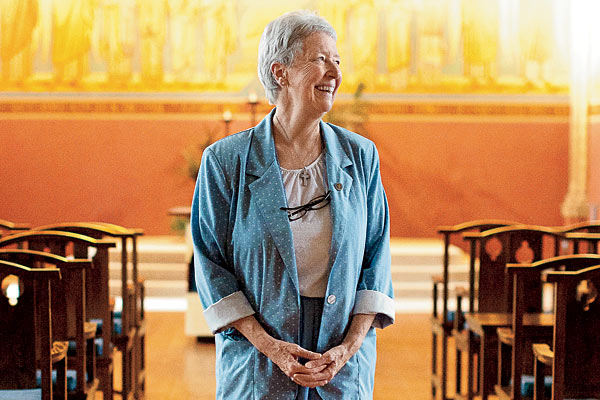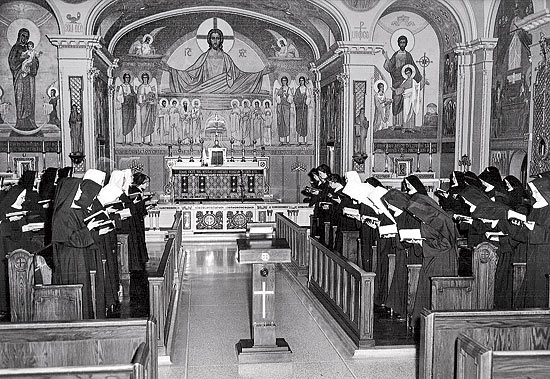Interview by Dirk Johnson

Sister Patricia inside the Benedictine chapel
In April, the Vatican criticized the Leadership Conference of Women Religious for “serious doctrinal problems” and “radical feminist themes.” How did you react to that rebuke?
I was startled. We all were. It was such a misrepresentation of who we are. We don’t teach doctrine. Our focus is service and pastoral care.
You recently returned from St. Louis, where the leadership conference convened to figure out its response. What was the upshot?
We want to dialogue [with church leaders], but we’re not going to do anything that threatens the integrity of who we are as an organization. We are going to stand firm.
The Vatican found fault with the American sisters for, among other things, not taking a hard stance against same-sex marriage. What is your personal view of gay rights?
Gay or straight, people are human beings and should have equal rights. Marriage is a complicated issue, I know. But I believe all human beings can commit to one another for life.
A popular bumper sticker declares: “You Can’t Be Pro-Choice and Catholic!” Or can you?
When I studied Catholic theology [while earning a master’s from Manhattan College], I learned that the essence of morality is conscience. Choices can be very complicated. Our role is to train people to develop consciences.
Do you believe the church should ordain women as priests?
I’m hedging here. Eventually, there will be room for that. I do understand that the church teaching is that only men can be priests. I believe firmly in the equality of men and women.
What are U.S. sisters doing that some people don’t know about?
We work in many areas of injustice that are unfortunately not in the spotlight, such as the trafficking of women and children. That was an issue that wasn’t getting a lot of attention. We feel that a lot of people are already focused on those issues that have political ramifications. We try to focus on things in a Gospel sense, with an emphasis on social justice.
What has it been like to work with Cardinal George?
He’s sometimes been controversial, but he’s a good man. In the late nineties, when I was executive director of Deborah’s Place, which provides support for the homeless, we were trying to convert an old convent [in Lake View] to a shelter. There was some not-in-my-backyard resistance, and the alderman in the ward was reluctant to support us [until] Cardinal George stood up for us. Our community is wishing him good health.
Your parents, Pat and Patty Crowley, were major figures in Chicago’s Catholic culture in the 1950s and ’60s. What did that mean in those days?
My parents started an organization in Chicago called the Christian Family Movement. It was a progressive group that got together and discussed the Gospel and what it meant for contemporary issues like racism and other things. It grew and eventually became an international organization.
Your parents were appointed to a commission on birth control during the Second Vatican Council in Rome. How did that affect them?
When they first went over to Rome, my parents believed in the traditional church teaching that birth control was intrinsically wrong. But my mother thought they should find out what Catholic families had to say about it. She read these heart-wrenching letters from faithful Catholics about the difficulties of life without birth control. They completely changed their views.
When did you decide to become a nun?
Probably in high school. I fought it for a long time. I enjoyed dating. I enjoyed my social life. Eventually, I listened to deeper voices.
If a 16-year-old told you she wanted to become a sister, what would you advise?
I don’t think a 16-year-old can make that choice validly. But I do think it’s a valid lifestyle: trying to live well and prayerfully with other people is something society needs.
This year, the Benedictine community you lead closed the 147-year-old all-girl St. Scholastica Academy. Was that a difficult choice?
It was a wrenching decision. But I saw the trends. Our enrollment was 134 students [in the 2010–11 school year], down from over 1,000 in the 1970s, and the school had spent down its financial reserves.
Why remain a Catholic?
I believe “the church” is not the hierarchical structure; it’s all of the people. We are the church. People sometimes think Catholics all think the same. But there is tremendous diversity, and Catholicism has an appreciation for that. So while I respect the church structure, it’s become too inbred and doesn’t reflect the richness of the church.
What do you tell Catholics who pray for change in the church?
Pierre Teilhard de Chardin, the priest and paleontologist, said that we have to believe in the slow work of God. And the Catholic Church works very slowly.
* * *
Nun the Less
Chicago’s shrinking population of women religious

Benedictine nuns at their Chicago chapel in the 1960s
1846: The year the first nuns—Mother Agatha O’Brien and four other Sisters of Mercy—arrived in Chicago. The first Benedictine nuns came in 1861.
9,500: Peak number of nuns in Chicago (1966)
1,781: Number of women religious in the Archdiocese of Chicago (2011)
78: Average age of the 43 women religious at Chicago’s Benedictine monastery
SOURCES: Archdiocese of Chicago; Encyclopedia of Chicago; Good Hearts: Catholic Sisters in Chicago’s Past, by Suellen Hoy; Sister Patricia Crowley
Photography: (Crowley) Chris Strong, (chapel) courtesy of Sister Patricia Crowley



